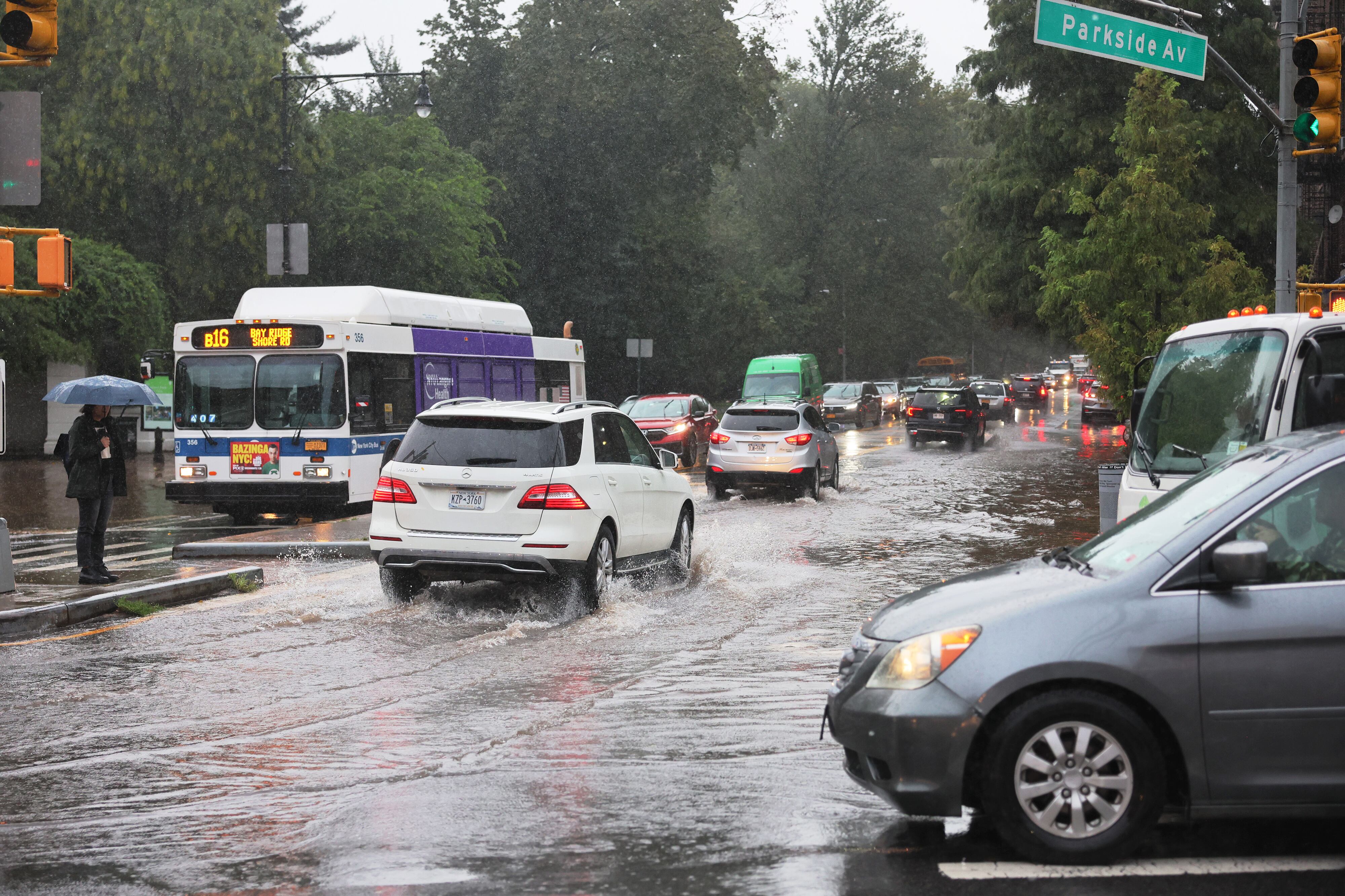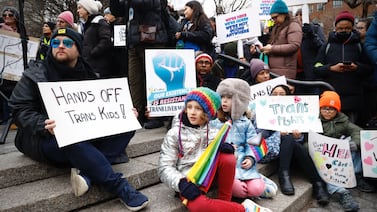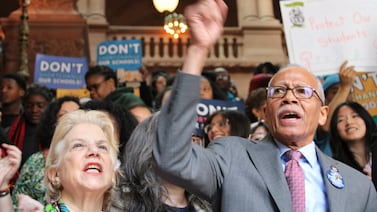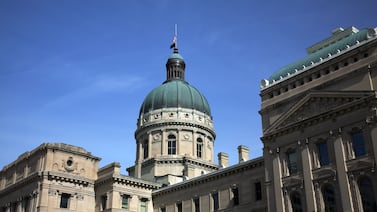Sign up for Chalkbeat New York’s free daily newsletter to keep up with NYC’s public schools.
Torrential rainfall sowed chaos for many New York City schools Friday morning, flooding 150 school buildings and throwing commutes into disarray for thousands of students and staff.
Mayor Eric Adams announced a shelter-in-place order for schools around noon. An Education Department spokesperson said it would lift with dismissal.
“If you are at work or school, shelter in place for now. Some of our subways are flooded and it is extremely difficult to move around the city,” Adams said at a media briefing on the storm.
The downpour, which dumped 5 inches in some parts of New York City by early Friday morning, affected service on every subway line, delayed dozens of school buses, and prompted both Adams and Gov. Kathy Hochul to issue a state of emergency. Friday’s attendance rate of 77% was significantly down from about 90% the day before.
Schools Chancellor David Banks said a total of 150 school buildings took on water Friday morning, and that one school, Brooklyn’s P.S. 312, was forced to evacuate because of a smoking boiler. Another Brooklyn school, I.S. 228 sent out a message asking parents to pick up students early, but Banks said the communication was premature.
The extreme weather led some parents and educators to question whether the city should have canceled in-person classes. Banks reassured families that schools were prepared to handle the storm.
“We have folks in our schools trained annually to prepare for days just like this,” Banks said, noting that schools were activating Building Response Teams in response to flooding. “While this was a tough day in terms of the rain, our kids are not in danger,” he added.
Many parents and educators reported that the rainwater had seeped into school buildings, flooding cafeterias and basements and leaking in through roofs, forcing students to move classrooms. On some campuses, children were soaked on their commutes to school, school staff reported.
“Some schools are being flooded from the basement up, and some are being flooded from the rooftop down,” said Paullette Healy, a parent leader in Brooklyn who said she’d heard from nine schools that experienced flooding. Several classrooms had to evacuate students, she added.
At P.S. 84 in Williamsburg, the school kitchen flooded, “which is a problem for our cafeteria workers and our kids,” said parent Jessamyn Lee. Fortunately, the custodial staff, she said, seemed to be able to “get the water intrusion under control.”
Meanwhile, at one Manhattan high school, rainwater leaking through a faulty roof forced students to move classrooms, complicating efforts to make up testing that had already been postponed because of tech glitches last week, according to a teacher, who spoke on the condition of anonymity.
“My school is doing the best they can,” the teacher wrote. “This is just weather and issues out of our control and I feel for the kids.”
Principals received dismissal guidance shortly before 2 p.m., suggesting they make sure that staff and students were aware of alternate exit routes in case of flooding and that they communicate alternative exits to families. Most schools dismiss between 2:20 p.m. and 2:50 p.m.
Public School Athletic League activities were canceled, and principals could decide whether to hold Saturday programs, according to the email.
Concerns about commutes home from school
Meanwhile, for the hundreds of thousands of students and staff trying to get to school Friday morning, the commute was messy and in some cases harrowing.
“The street leading up to my school is completely flooded,” said Leah Ali, a student at Bard Early College High School in Manhattan. “As cars drive past, water reaches their headlights, and waves of water crash over students trying to make it inside.”
Alan Sun, a senior at The Bronx High School of Science, said the school has been affected by the storm. “The ceilings have been leaking water and the cafeteria is flooded,” he wrote in a text message. “Lunch is now being served in the auditorium.” Sun opted to eat in the hallway instead, as the auditorium was too crowded.
Morning disruptions on nearly every subway line left many students wondering how they’d safely get home.
“With train service suspensions, track fires, and stations flooded, commuting back home to Queens is a serious concern for me,” Ali had said in the morning.
At dismissal, she was still trying to figure out how to get home since her trains were delayed.
“I might be waiting at the station for a while,” she said. “Unfortunately, my school is a 15-minute walk away from the station, and buses aren’t working at the moment, so I’ll be taking an Uber there.”
Sun, who commutes to Bronx Science by subway, also said he was worried about the trek back to Flushing, Queens, at the end of the day. “I’m hoping the flooding in the subway stations won’t be too bad,” he wrote.
In her guidance to principals sent at the end of the day, Deputy Chancellor of School Leadership Danika Rux wrote, “Please ensure that your students who use public transportation have secured routes home.”
State and transportation officials said that getting the subways back up and running was a top priority, but that MTA buses were in operation and that the agency would deploy extra buses as a backup in case train service wasn’t restored by dismissal time.
The disruptions also affected students traveling by road.
The city’s Office of Pupil Transportation reported roughly 140 weather-related school bus delays as of 1 p.m. Friday afternoon.
Major roadways including FDR Drive were closed Friday morning, adding to concerns about disrupted afternoon commutes.
Banks said that the Education Department dispatched school buses early for the afternoon pickup, so they would be ready by dismissal time. School buses sit high enough off the ground that they are less likely to get stalled by roadway flooding, he said.
Mayor Adams defends NYC’s response
The city’s Education Department first addressed the weather conditions late Thursday night in a series of posts on X, formerly known as Twitter, advising that schools would remain open Friday and suggesting that families and educators leave extra time for their commutes, take major roads, and not enter flooded subway stations.
No systemwide emails had gone out to teachers or parents as of 1 p.m. on Friday.
Several parents and educators said Friday that the city should have closed school buildings on Friday and pivoted to remote learning, similar to snow days, or at the very least improved communication about the risks.
“It’s quite a lapse in safety and concern when our phones send us messages about life threatening flooding and not to travel,” said the Manhattan teacher. “New York City is unprepared for major flooding as a result of climate change and this is more of the same examples we’re seeing.”
Adams defended the decision to keep schools open.
“This was the right call. Our children are safe in schools,” he said. “There is a big inconvenience when you close the schools.”
Climate change fears prompt worries for school infrastructure
The intensity of the flooding caught some parents by surprise. Avery Cole, whose 5-year-old daughter attends P.S. 11, said she wasn’t aware that the weather was going to be so severe until her phone started blaring with emergency alerts after she dropped her child off.
She also received a message from the school pleading for volunteers to help dry and disinfect its ground-floor classrooms “to prevent mold and save as much furniture as possible.”
Cole said she worries that school buildings aren’t prepared for more intense storms and wildfire smoke stoked by climate change.
“These storms are going to be more dramatic and frequent and schools are bearing the brunt of it,” she said.
Rohit Aggarwala, the commissioner of the city’s Department of Environmental Protection, was blunt about the increasing threat of climate change to New York City.
“This changing weather pattern is the result of climate change,” he said, “and the sad reality is our climate is changing faster than our infrastructure can respond.”
Michael Elsen-Rooney is a reporter for Chalkbeat New York, covering NYC public schools. Contact Michael at melsen-rooney@chalkbeat.org.







